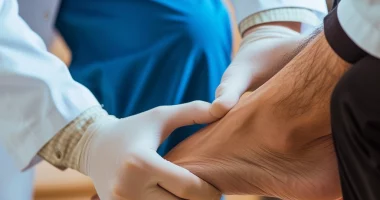Hand fracture
General information
Hand fracture is a violation of the integrity of the bony structures in this area under the influence of external forces or internal factors. The condition requires emergency care, comprehensive diagnosis, and immediate treatment. The diagnosis of “fracture of the hand” and the subsequent therapy are dealt with by traumatologists and surgeons.
A hand bone fracture is one of the most common types of traumatic injury to the hand. It occurs as a result of sudden and severe pressure, which is most often seen in falls with the hand resting on the hand. A hand fracture can also be caused by an attempt to defend oneself from an attack, a collision with large objects on the run, and a patient stopping abruptly with their hands in front of them.
Injuries of this nature are not uncommon in athletes, dancers, wrestlers, and people who engage in extreme hobbies such as parkour and jumping.
Classification
Like any other fractures, hand trauma can be closed when soft tissues are not damaged and open, in which violations of the integrity of bone structures are visible to the naked eye. Depending on the localization, the following types of hand injuries are distinguished:
- wrist fractures, which include injuries to the navicular, semilunate, and pisiform bones;
- metacarpal fractures;
- fractures of the phalanges of the fingers.
Given their origin, fractures can be pathologic and traumatic. Pathological injuries occur in people who have osteoporosis and other diseases that affect the density and mineral composition of bone tissues. Each type of injury has specific features that affect the clinical picture of the disease, treatment tactics, and healing time.
Symptoms
The first sign of a hand and wrist fracture is severe, piercing pain that occurs at the time of injury or a few seconds after the injury. Patients with a reduced pain threshold may even briefly lose consciousness.
Other symptoms of a fracture of the hand and wrist of the arm are:
- pronounced tissue swelling that spreads to the forearm;
- limited mobility of the limb;
- The appearance of hematoma or lividity on the skin in the area of injury;
- unnatural deformity of the hand;
- hot to the touch skin in the area of the lesion;
- characteristic crunching (crepitation) when trying to move the hand or fingers;
- abnormal mobility at the fracture site.
In an open fracture of the hand, the main symptom is a wound on the hand in which bone fragments are visible. There may be minor bleeding due to damage to blood vessels.
Diagnosis
The initial diagnosis is made based on a face-to-face examination. The traumatologist examines the injured limb, clarifies the circumstances and time of injury, and evaluates the patient’s complaints. Since the signs of a closed hand fracture are similar to a wrist sprain, an additional study is carried out using radiography performed in several projections.
In addition, if necessary, in complex cases, a set of basic laboratory tests is carried out, and the patient is referred to CT or MRI to conduct an ultrasound of minor joints.
Surgery for hand fractures
Conservative therapy is used only for superficial injuries without joint displacement and bone fragments. In all other cases, surgical intervention is indicated.
Several surgical methods are available for treating fractures of the hand and wrist. The specific method is selected based on the nature of the injury, the volume of damaged bones, and the patient’s personal health parameters.
Bone osteosynthesis
The procedure consists of creating favorable conditions for the natural fusion of bone fractures. For this purpose, the fragments are fastened with special devices and fixed in an anatomically correct position. Depending on the complexity and localization of the injury, traumatologists perform operations using closed and open access. In the first case, the intervention is performed through punctures or small incisions under constant X-ray control—the advantages of such intervention – in its minimally invasive and rapid rehabilitation of patients. In the open method, the fracture site is accessed through the skin and soft tissue incision, the juxtaposition of the fragments, and the insertion of fixators using surgical instruments.
Bone grafting
It involves placing healthy bone tissue from the patient/donor or its artificial counterparts into the area of injury, accelerating the fusion and regeneration process.
Arthrodesis
The procedure is indicated in case of extensive multiple multifocal injuries. It involves immobile fixation of the bones with artificial materials in a functionally appropriate position. Movement in the joint is stopped in this case. Arthrodesis is performed using endotracheal anesthesia or epidural anesthesia. In some cases, doctors use arthroscopy – a minimally invasive technique, when surgical intervention is performed through several punctures. The technique of the operation depends on the type of surgical intervention chosen by the surgeon, but in general, includes the following stages:
- making punctures in the joint area to insert the arthroscope and other necessary instruments;
- opening up the joint and removing the cartilage;
- fixation of the joint by the selected type of surgical intervention;
- suturing;
- the application of clips or orthotics.
Endoprosthetics
It is performed by replacing part of the bone structures with synthetic implants.
Subsequently, the patient is prescribed a course of rehabilitation and conservative supportive therapy.
All these treatment options are available in more than 800 hospitals worldwide (https://doctor.global/results/diseases/hand-fracture). For example, Wrist fracture surgery can be done in these countries at following approximate prices:
Turkey $3.0 K in 32 clinics
China $9.5 K in 6 clinics
Germany $9.9 K in 40 clinics
Israel $11.5 K in 16 clinics
United States $14.3 K – 63.1 K in 19 clinics.
Rehabilitation
The recovery speed depends on the type and severity of the hand injury. On average, the rehabilitation period takes from 3 to 8 months. During this time, the patient will need to wear a fixation bandage and follow the attending physician’s recommendations. To stimulate the recovery process and return normal mobility of the hand are prescribed:
- massage;
- physical therapy techniques;
- therapeutic exercise.
The prognosis for recovery depends on the patient’s age and functional status, the complexity of the fracture, and the speed of seeking help. In most cases, the hand recovers completely if the doctor’s instructions are followed.


